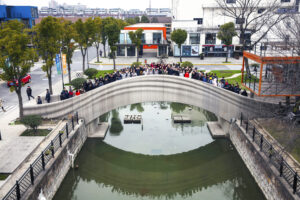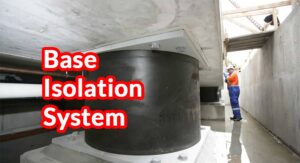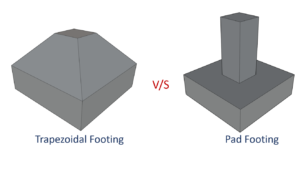
6 Types of Rollers Commonly Used for Compaction Work
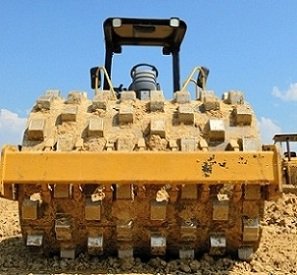
Types of Rollers
Depending upon the project requirement and soil to be compacted, different types of rollers are used for compaction work. The various types of rollers which are used for compaction are:
- Cylindrical Rollers
- Sheepsfoot Rollers
- Pneumatic tyred Rollers
- Smooth wheeled Rollers
- Vibratory Rollers
- Grid Rollers
The following types of road rollers are generally used.
1. Cylindrical Roller
- This is a light roller of iron, concrete or stone; drawn by hand or bullocks. The size varies, but it is generally about 1 metre in dia. and about 1.5 metre long.
- This ground pressure generated by this type of roller is about 7 kg/cm2.
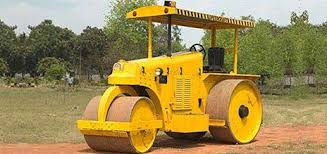
2. Sheepsfoot Roller

- As the name indicates, this type of roller consists of a drum having many round or rectangular shaped protrusions or “feet” on it. These rollers are also called tamping rollers.
- Various types are available having different diameters and widths of drum and different lengths and shapes of feet. The most common type is the one having two drums 1.22 meters wide and 1.06 either as taper-foot or club-foot rollers according to the shape of the feet.
- Area of each protrusion can vary from 30 to 80 cm2.
- The coverage area is about 8 to 12%.
- The thickness of compacting layer is kept about 5 cm more than the length of each foot.
- This type of roller mostly used for compaction of cohesive soils such as heavy clays and silty clays. Not effective with sandy soils.
- The weight of the drum can be increased by filling the drum with water or damp sand.
- The factors that governs the amount of compaction of soil are as follow:
- Gross weight of the roller
- Area of each feet
- No of feet or lugs in contact with ground
- Total no of feet per drum
- Maximum pressure is exerted on soil when a foot is vertical.
- The soil is supposed to be consolidated when the impression by the projecting teeth is not more than 12 mm deep or when the surface has been rolled 16 to 20 times.
- 10 to 20 passes are generally required to give complete coverage.
- The density of the consolidated soil should be about 1.48 kg/cm3. The top layer has to be finished with a smooth wheel roller.
- Pressure on the feet may be increased by filling the drum with wet sand or some other material, which may be 4 to 7kg/cm2 for light rollers and upto 25 to 70 kg/cm2 for giant rollers.
3. Smooth Wheeled Roller
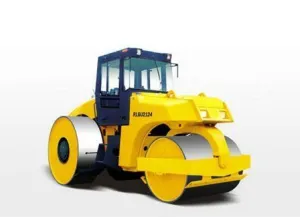
- This type of roller consists of a large steel drum in front and one or two wheels or drum on the rear end.
- Depending upon the number of wheels on the rear, it can be of following two types:
- Tandem rollers (having one wheel at rear and one wheel in front)
- Three wheeled rollers (having two wheel at rear and one in front)
- The weight of tandem roller varies from 2 to 8 tonnes and that of two wheeled roller varies from 8 to 10 tonnes.
- It ground coverage provided by smooth wheeled roller is 100%.
- The weight of the roller can be increased by filling the inside space of the drum with water or wet sand. This is called ballasting.
- The ground pressure exerted by tandem rollers is about 10 to 17 kg/cm2.
- Performance of smooth wheel roller depend upon it load per cm width and diameter of the roll.
- The speed and number of passes of a smooth wheeled roller depends on the type of soil to be compacted and project requirements. The optimum working speed has found to be 3 to 6 km/h and about 8 passes are adequate for compacting 20 cm layer.
- Smooth wheel rollers are most suitable for consolidating stone soling, gravel, sand, hard core, ballast and surface dressings. Not suitable for consolidating embankments and soft sub-grades, but are better suited than any other plant for compacting silty and sandy soils and with fewer passes. When the moisture content is a little more than optimum it will compact more easily.
- The two types (i.e. steam and diesel) are very much alike, the difference being mainly in power unit. Adjustable weight devices are available which can be fitted to the wheels so that the rolling pressure can be varied to suit different consolidation requirements. When engaged on heavy work, the sliding weights must always be at the rear of the roller. The sliding weight must never be moved when the roller is on a gradient.
- The steam road roller can stand heavier wear and tear and is much simpler to work than the diesel roller but it takes over an hour to start up and cannot be temporarily shut off, while the diesel type can be started up and shut down in a few minutes and does not consume fuel when standing temporarily idle on a job. Steam road rollers are now getting outdated. Diesel rollers are cheaper in running cost.
- Some rollers are made with its prime movers or engine as a separate unit which is a tractor, and is mounted on the roller, and which has its own advantages.
- Scrappers are provided on all the wheels in adjustable positions covering the full width of the roll, with water sprinkling arrangement, for scraping of the mud and keeping the wheels clean during rolling.
- The maximum grade a road roller can climb is 1 in 5.
4. Vibratory Rollers

- This type of roller is fitted with one or two smooth surfaced steel wheels 0.9 m to 1.5 m in diameter and 1.2 m to 1.8 m wide.
- Self propelled vibratory rollers are now available weighing from 4 to 6 tonnes.
- Vibrations are generated by the rotation of an eccentric shaft inside.
- A vibratory roller is used for compacting granular base courses. It is sometimes used for asphaltic concrete work.
6. Grid Rollers

- These rollers have a cylindrical heavy steel surface consisting of a network of steel bars forming a grid with squire holes and may be ballasted with concrete blocks.
- They are generally towed units and can operate at speeds between 5 and 24 km/h.
- Typical weights vary between 5 tonnes net and 15 tonnes ballasted.
- Grid rollers provide high contact pressure but little kneading action and are suitable for compacting most coarse grained soils.


